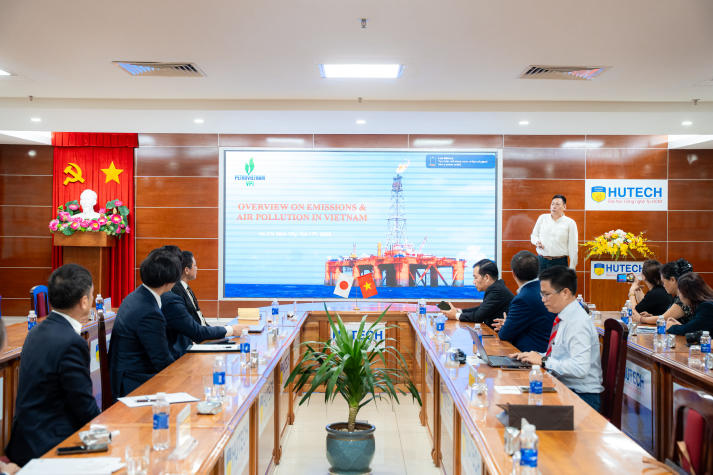DETAILED REPORT ON THE PRESENTATION BY DR. NGUYEN HUU LUONG (VPI)
At the Vietnam–Japan Hydrogen Workshop 2025
Date: October 17, 2025
Venue: Ho Chi Minh City University of Technology (HUTECH)
Organizers: Vietnam Association for Hydrogen and Clean Energy (VAHC), HUTECH University, and Suiso Japan Co., Ltd

1. Overview of Emissions and Air Pollution in Vietnam
Dr. Nguyen Huu Luong, from the Vietnam Petroleum Institute (VPI), delivered a presentation titled “Overview on Emissions and Air Pollution in Vietnam.”
He provided a comprehensive picture of the country’s current air quality and emission status, citing data from OECD (2025) and C2ES (2021).
Vietnam faces alarming levels of air pollution, ranking 14th among 118 countries with the most polluted air in 2022. Hanoi and Ho Chi Minh City are listed among the 15 most polluted cities in Southeast Asia.
Fine particulate matter (PM2.5) is a particular concern: in 2019, Hanoi had only 8 days and Ho Chi Minh City 36 days with PM2.5 levels below the national standard of 50 µg/m³. The main pollution sources are transportation, industrial activities, construction, agriculture, handicraft production, and weak waste management (MONRE, 2024).
2. Emissions by Sector and Reduction Directions
Dr. Luong analyzed Vietnam’s CO₂ emissions across key sectors, including power generation, transportation, and hard-to-abate industries such as cement, steel, refining, and fertilizer production.
-
Power Sector: According to Decision No. 500/QD-TTg (2023) and 768/QD-TTg (2025), Vietnam plans to expand solar and offshore wind power, promote hydrogen/ammonia co-firing in power plants, and gradually integrate carbon capture and storage (CCS) technologies.
-
Transportation Sector: Under Decision No. 876/QD-TTg (2023), Vietnam aims for 10–20% electric vehicles (EVs) by 2040 and 40–60% by 2050, targeting net-zero emissions by 2050 through the use of biofuels, sustainable aviation fuels (SAF), and hydrogen.
-
Hard-to-Abate Industries: VPI has identified 10 potential CO₂ clusters in major industrial regions (Red River Delta, North Central, Dung Quat, Phu My, etc.) and proposed establishing CCUS hubs by 2035 to decarbonize steel, cement, and refining sectors.
3. Solutions and Recommendations
Dr. Luong outlined integrated solutions in four main areas:
-
Emission Management: Real-time monitoring, pollutant concentration limits, and energy-saving roadmaps.
-
Advanced Technologies: Hydrogen (GH₂/GNH₃) co-firing, CCUS, EV/FCEV deployment, electrolysis, and exhaust treatment systems (SCR, DEF).
-
Clean Energy Development: Expansion of renewables (solar, wind, nuclear) and energy storage (BESS).
-
Policies & Incentives: Subsidies, carbon pricing, and a national carbon market, expected to evolve from around 5 USD/tCO₂ to 50–100 USD/tCO₂ by 2050.
4. Conclusion
Dr. Nguyen Huu Luong emphasized that Vietnam is on the right track toward emission reduction and energy transition but must accelerate investment in hydrogen, CCUS, and renewable technologies, alongside stronger international cooperation to achieve its Net Zero 2050 goal.
His presentation received strong interest from both Vietnamese and Japanese delegates, fostering future collaboration on hydrogen development and carbon reduction technologies in Vietnam.






